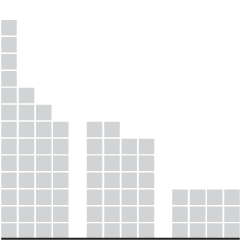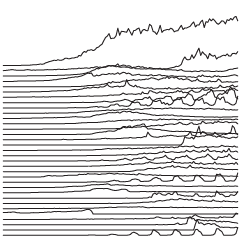Geographers from Kansas State University map the spatial distribution of the seven deadly sins in the United States. These types of maps are always kind of iffy as they draw from data from various sources gathered with different methods and usually use some kind of researcher-defined metric. Still interesting though… right?
Read More
-
-
Flygbussarna, a Swedish coach bus company, in partnership with the Acne marketing group, assembled 50 cars into one bus to highlight the production of carbon emissions. Assuming slightly more than one person per car on average, one coach bus could potentially replace 50 cars on the road and reduce carbon emissions some 10 times over. Read More
-
In a collaborative initiative between Copenhagen Institute of Interaction Design and The Danish Design School, the Interaction Design Pilot Year brings together students and faculty from various disciplines for a unique brand of education. Read More
-
It’s time for a FlowingData poll. I want to know what data-ish things you’re interested in. Design? Statistics? Analytics? Select your answer in the poll below. If you select other, let us know what that other thing is in the comments.
{democracy:8} -
You might not know it, but there are actually a ton of data and visualization blogs out there. I’m a bit of a feed addict subscribing to just about anything with a chart or a mention of statistics on it (and naturally have to do some feed-cleaning every now and then). In a follow up to my short list last year, here are the data-ish blogs, some old and some new, that continue to post interesting stuff. Read More
-
Jack Schulze provides this horizonless view of Manhattan:
Here & There is a project by S&W exploring speculative projections of dense cities. These maps of Manhattan look uptown from 3rd and 7th, and downtown from 3rd and 35th. They’re intended to be seen at those same places, putting the viewer simultaneously above the city and in it where she stands, both looking down and looking forward.
Imagine a person standing at a street corner. The projection begins with a three-dimensional representation of the immediate environment. Close buildings are represented normally, and the viewer himself is shown in the third person, exactly where she stands.
It takes a minute to wrap your head around the concept, but it’s an interesting one. It bet it’d be especially awesome if it were an interactive map that you could use while you roamed around a dense city. What do you think, cartographers?
-
A couple weeks ago, FlowingData ran another Visualize This challenge. I posted a dataset on the number of days it takes the average person in each state to pay his or her taxes and asked you to visualize it. The number of days vary, because tax burden varies state-by-state. The day all taxes have been paid is dubbed Tax Freedom Day. Alaska has the earliest Tax Freedom Day while Connecticut has it last.
Here are the interesting results you all came up with. Thanks to those who participated. Nice work all around. Read More
-
This graphic, from Mike Arauz, describes different levels of online friendship, starting at passive interest (read your blog but not much else) up to investment (deeply care about your success). I originally thought it was just one of those comic infographics, but there’s some good discussion going on in the comments of the original post and the Arauz’ response.
[Thanks, @JeffHurt]
-
While The New York Times continues to produce excellent work, GOOD Magazine has been churning out interesting graphics on the other side of the spectrum. In their most recent transparency graphic, GOOD describes the drugs that pose the greatest danger according to local law officials, when asked by the Department of Justice. Underneath the creative bling is essentially a stacked bar chart. The purists are going to cry bloody murder, but hey, it still gets the point across, right?
Have a nice weekend, everyone. See you Monday.
[Thanks, @joaovc]
-
Red Hat, an open source leader best known for their Linux distribution, maps open source activity around the world. If you’re not a developer or involved with Web-ish things, open source might seem like a foreign concept. Give away your code, your work, and your data. And succeed? I don’t know how it works, but somehow, it does. Open source not only helps an application flourish, but also helps ideas develop further than they ever would with a single group. Plus – it makes my life, and many others’ lives much easier.
-
Google announced today that they have made a small subset of public datasets searchable. Search for unemployment rate and you’ll see a thumbnail at the top of the results. Click on it, and you get a the very Google-y chart like the one above, so instead of searching for unemployment rates for multiple years, you can get it all at once.
Read More -
-
NPR provides an in depth view of the U.S. electric grid, exploring the network, power sources, and where in the country power is coming from:
The U.S. electric grid is a complex network of independently owned and operated power plants and transmission lines. Aging infrastructure, combined with a rise in domestic electricity consumption, has forced experts to critically examine the status and health of the nation’s electrical systems.
The above is a view of the grid; below is a view of nuclear and solar energy across the country.
Read More -
The US Census Bureau, World Bank, and OECD have organized a seminar to discuss innovations in visualization and blossoming Web technologies to disperse the stories in data. Innovative Approaches to Turn Statistics into Knowledge will be held July 15-16, 2009 in Washington, D.C.
While dynamic graphics and communication tools are at the heart of the seminar, we also want to focus on a broader range of tools. The seminar will also include the use of videos, as explored by GapMinder and others, and participative approaches, as seen in some web 2.0 initiatives; and – although innovative tools are themselves of great interest, and worthy of being presented at the seminar – the focus of the seminar will be on innovative applications of tools, for example, so-called story-telling applications.
With participants [pdf] from all over the world and major organizations, and no registration fee, the seminar looks promising. Hurry though, there are only three days left to sign up. The deadline is April 30.
-
The ever popular newsmap (above), a tree map view of Google News, got a facelift a few
daysweeks ago. Markos Wekamp, the creator, has changed to a rectangularized tree map layout to display headlines more completely, search as you type, and deep linking. Markos also brings the brightness down a notch from that of the original, which I like. It’s easier on the eyes.Earlier last week, Google released its own alternative news view with News Timeline. The interface lets you search the news, blogs, etc and results are displayed in a timeline format. Show by day, month, year, and decade.

The jury is still out on whether the timeline is an improvement over regular search listings. What do you think? How about versus the New York Times article skimmer?
[via infosthetics & Google News Blog & Newsmap Blog]
-
I’m thankful for the opportunity I had to work at Google. I learned more than I thought I would. I’ll miss the free food. I’ll miss the occasional massage. I’ll miss the authors, politicians, and celebrities that come to speak or perform. I’ll miss early chances to play with cool toys before they’re released to the public. Most of all, I’ll miss working with the incredibly smart and talented people I got to know there. But I won’t miss a design philosophy that lives or dies strictly by the sword of data.
— Douglas Bowman, Goodbye, Google, March 2009I feel like I’ve been hearing a lot of this type of stuff recently. Just yesterday, while watching NBA playoff commentary, someone stated that future Detroit Lions quarterback, Matthew Stafford, had something like a 1 in 4 chance of success in the NFL. Charles Barkeley replied that sometimes you gotta forget about stats and just go, or something to that effect. Oddly enough, I agree.
[via TechCrunch]
UPDATE: Kevin Fox, (formerly) senior user experience design lead at Google, responded to Bowman’s post: “I don’t think Google had to be a bad fit for you, but that you were put in to the wrong role.” [Thanks, David]
-
This graphic from New Scientist shows when certain natural resources will run out in the world if we continue at the current consumption rate. However, reader beware, this graphic feels more like eye candy than real data. I’m no ecologist, but something about these numbers doesn’t seem quite right. Completely out of gold in the entire world in 45 years? No more indium (for LCDs) in 13 years? I don’t quite get the comparison between world consumption rate vs half of the US consumption rate. Why half? Again, I’m no ecologist, so maybe this is totally normal. I dunno. Maybe someone who knows better than me can chime in here.
Data assumptions aside, the design is interesting. A little scattered – but interesting. Can you think of some ways to make this graphic more informative?
-
What exactly is a doer? Feeling much like a segment on Sesame Street, this ad from Honda explains, “Well, doers do things. Things to move us forward, to make stuff better.” The ad (below) goes on to imagine a world where people and companies are doers who take an active role in making environmentally conscious decisions.
[via Cool Infographics]
-
There are over 10,000 street vendors in New York City. But how much do you know about them? The Street Vendor Project, in collaboration with the Center for Urban Pedagogy and Candy Chang, provide a visual guide [pdf] in an effort to show the world of street vendors. Wow, that sentence had a lot of interesting names in it. Um, sorry, I digress.
The guide briefly explains vendor regulations, rights, and what a better system might look like – and with an average $14,000 salary, there’s certainly room for improvement. There is also a bit of history and demographics with business that began as pushcarts (e.g. Bloomingdale’s) and now celebrities (e.g. Jerry Seinfeld) who at one time or another were street vendors.
There is also a second guide [pdf] for the street vendors themselves. Make sure you take a picture of that smiley, abusive policeman.

[via New York Times]
-
I was going to let this one slide, but people kept commenting, essentially trashing FlowingData, and that’s just not cool. As you might recall, I put in my picks for the best data visualization projects of 2008 a while back. They were the fine work of statisticians, designers, and computer scientists, all of them beautiful, and all of them built to tell an interesting story with the dataset at hand. None of them were traditional graphs or charts.
Read More



 Visualize This: The FlowingData Guide to Design, Visualization, and Statistics
Visualize This: The FlowingData Guide to Design, Visualization, and Statistics










